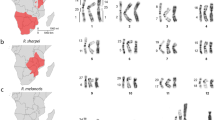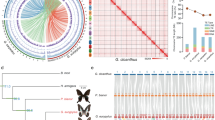Abstract
ONE general fact which emerges from, recent work in animal cytology is that the extent of the heterochromatic ('inert') segments of the chromosomes often varies very greatly from one species to another, even within the same genus. Thus, among the grasshoppers, Stauroderus scalaris possesses very large proximal heterochromatic regions in all the chromosomes, while in other species of the genus these regions are very much shorter and less conspicuous1. The same difference has long been known to exist between species of Drosophila, where D. virilis has the proximal half of each autosome heterochromatic, while in some other species such as busckii there is far less heterochromatin. These species belong to different subgenera ; but it has recently been shown by Wharton2 that D. melanopalpa has considerably more heterochromatin than the very closely related repleta. In the Pentatomids, Schrader3 has shown that Edessa irrorata has prominent heterochromatic blocks at the ends of most or all of its chromosomes, which are not obvious in several other members of the same genus. An identical situation occurs in the Corixidæ, where Slack4 has shown that Corixa punctata is a species with unusually extensive heterochromatin.
This is a preview of subscription content, access via your institution
Access options
Subscribe to this journal
Receive 51 print issues and online access
$199.00 per year
only $3.90 per issue
Buy this article
- Purchase on SpringerLink
- Instant access to full article PDF
Prices may be subject to local taxes which are calculated during checkout
Similar content being viewed by others
References
Corey, J. Morph., 55, 313 (1933).
Wharton, Univ. Texas Publ. No. 4313, 282 (1943).
Schrader, J. Morph., 69, 587 (1941).
Slack, Proc. Roy. Soc., Edin., 58, 192 (1938).
Slack, Chromosoma, 1, 104 (1939).
Darlington J. Genet, 39, 101 (1940).
Author information
Authors and Affiliations
Rights and permissions
About this article
Cite this article
WHITE, M. Amount of Heterochromatin as a Specific Character. Nature 152, 536–537 (1943). https://doi.org/10.1038/152536b0
Issue date:
DOI: https://doi.org/10.1038/152536b0
This article is cited by
-
Vergleichende Histologische Untersuchungen anPolyergus rufescens Latr. undRaptiformica sanguinea Latr.
Insectes Sociaux (1972)
-
Application de méthodes d’analyse biochimique à un problème taxonomique: les Corégones du lac de Neuchâtel1, 2, 4
Schweizerische Zeitschrift für Hydrologie (1960)
-
Versuch einer Kernanalyse bei den somatischen Hodenzellen der Aphodius-Arten (Coleoptera, Scarabaeidae)
Chromosoma (1953)
-
The heterochromatin problem in cytogenetics as related to other branches of investigation
The Botanical Review (1949)
-
Structure of Heterochromatin
Nature (1944)



